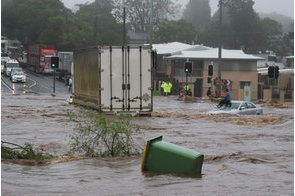Measuring and reducing your organisation's carbon footprint

Summary
Your organisation's motivations for calculating its carbon footprint are important as that determines how and what you measure.
The impacts of climate change have brought about significant risks and opportunities to people, businesses and economies. The world is already seeing the effects of climate change predicted by scientists. According to the United States National Aeronautics and Space Administration (NASA), some of these effects include heavy downpours, flooding, intense heat waves, frequent wildfires, longer periods of drought in some regions and an increase in the number, duration and intensity of tropical storms.
In Lagos State, the commercial capital of Nigeria, the affluent neighbourhoods of Ajah, Ikoyi, Lekki and Victoria Island woke up one Saturday morning in June 2017 to find their roads, houses and other property flooded due to heavy rainfall. The damage to property was estimated to be in billions of naira. The cause of the flood, as echoed by the Lagos State government, was an overflow of the lagoon, resulting from the rise in sea level.
Similarly, in September 2017, some parts of Benue State were flooded, leading to the displacement of about 110,000 people. Farms in the affected areas were destroyed. Furthermore, the increasing desertification in some parts of northern Nigeria and the massive contraction of Lake Chad have not only led to devastating impacts on farmlands and settlement areas. There are also ripple effects, such as the increasing internal migration of herdsmen and their cattle, a situation that has posed significant security risks to the country as we have witnessed in recent times.
Why should your organisation be concerned?
If current climate trends continue, there would be a reduction in potential output of a segment of the manufacturing sector that depends on agriculture produce for inputs. There would also be a decline in oil production as a result of possible submergence of oil wells in coastal regions as the sea level rises.
As climate change mitigation and adaptation costs mount, the entire economy could be imperiled. For instance, consumers may lose their homes if they have no insurance cover and have to foot the restoration costs themselves in the event of damages due to flooding or a storm. Also, businesses that depend on increasingly volatile commodities, and those providing insurance claims, would also be affected.
However, climate change is also generating a lot of business activities and climate investment opportunities through mitigation and adaptation initiatives. Such opportunities include investment in renewable energy, sustainable agriculture, and creation of more resilient cities. In addition, your organisation can benefit from sustainability strategies like reduced operating costs as a result of increased energy efficiency and reduced waste production.
Evaluating your carbon footprint enables your organisation to take some initial steps to adapt to a changing world and create a more resilient business. Hence, it is crucial to reduce your own impact in order to reduce the risks and take advantage of the opportunities. But the initial step is to measure your carbon emission.
Measuring your organisation’s carbon emissions can provide a consistent, accurate and transparent look at the quantity of carbon your business produces. You can measure your emissions by calculating your carbon footprint, which is the total output of greenhouse gas (GHG) emissions caused by your organisation, event, product or person.
A carbon footprint does not only mean emissions of carbon dioxide (CO2); it also includes emissions of five other Kyoto Protocol greenhouse gases, which are methane (CH4), Nitrous oxide (N2O), Hydrofluorocarbons (HFCs), Perfluorocarbons (PFCs) and Sulphur hexafluoride (SF6).
Carbon footprint is measured in tonnes of carbon dioxide equivalent (tCO2e). Carbon dioxide equivalent (CO2e) allows the different GHGs to be compared on a like-to-like basis relative to one unit of carbon dioxide. CO2e is calculated by multiplying the emissions of each of the six GHGs by its 100-year global warming potentials (GWP), using the Intergovernmental Panel on Climate Change (IPCC) GWP factors.
Why should your organisation measure its carbon footprint?
Your organisation’s motivations for calculating its carbon footprint are important as that determines how and what you measure. For instance, if you only wanted to report internally in your business as an avenue of engaging your stakeholders, how and what you measure would be different than if you were reporting to a legislative framework for mandatory carbon accounting.
Below are key steps your organisation can take to manage its carbon footprint:
1. Define your organisation’s emissions: There are three globally agreed scopes for considering and measuring GHG emissions. The first scope measures the direct impact of your organisation, or emissions that are produced by assets that your organisation owns. The asserts include company vehicles and fuel use on-site (e.g. fuel used by electricity generator). The second scope measures emissions you do not produce but consume, which include electricity usage (from national grid) and natural resources. The third scope measures the impact of your employees, contractors and customers and the GHG they produce, including air travel, waste, contractor-owned vehicles, customer-owned vehicles, outsourced activities, and commuting.
2. Reduce your organisation’s emissions: From calculating your organisation’s GHG emissions, the next step is to reduce the emissions. Identifying areas where your organisation can reduce emissions will, in the medium- to long-term, result in cost savings, in terms of transport, energy, waste and packaging without negatively affecting productivity. Set an annual reduction target – this will give your organisation a goal to work towards and help you stay on track.
3. Verify your organisation’s emissions: There are many different things your organisation could measure as part of your carbon footprint. For example, a basic carbon footprint measures the footprint of your directly-purchased energy consumption (annual electric use (in kWh) and annual on-site fuel use (in litres)) multiplied by the carbon conversion factors provided by the IPCC and then added to obtain the total business carbon footprint from purchased energy. Verifying your carbon footprint will assess whether or not your organisation is measuring the right things – that is, if the information has been captured accurately – and help to identify how you can reduce emissions. We can advise your organisation on who can provide assurance and verification for your carbon footprint.
4. Report your organisation’s emissions: It is important to let your stakeholders know about your target and how you are tracking your emissions. Your organisation might want to do this as part of your sustainability report, or internal report, and publish it on your website or in annual reports. The important thing is being transparent and open to stakeholders so they can see the journey your organisation is on and how they can help you achieve your goals.
How do you get going? The most important step is to start!
Dr. Emmanuel Chukwuma Ogbonna, a Financial Nigeria Guest Writer, is President, Foundation for Sustainable and Healthy Environmental Development (FSHED). He is also an expert in Renewable Energy and Sustainability. Email: emmanuel.ogbonna1@gmail.com
Related
-
Rockefeller Foundation, USAID invite entries on flood management in Africa and Asia
The Global Resilience Partnership is requesting for innovative ideas to build resilience to water challenges.
-
Avoiding a climate lockdown
Global warming will cause drinking water to degrade and enable pollution-linked respiratory diseases to thrive.
-
UN calls for urgent action to limit climate change catastrophe
A new report has called for unprecedented and urgent action within the next 12 years to limit global warming.







